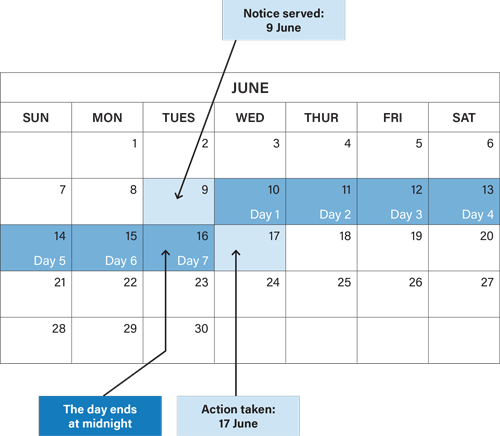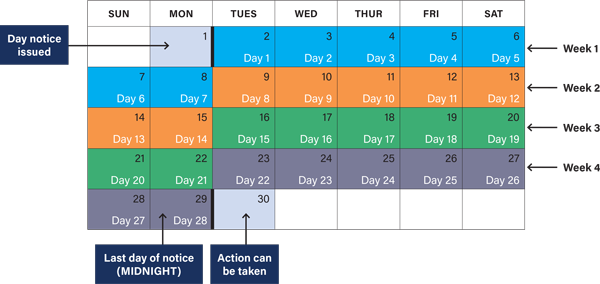Allowing time when serving notices
In a tenancy, notice must be given before certain actions are taken as set out in the Residential Tenancies and Rooming Accommodation Act 2008 (the RTRA Act). This applies to actions by both managing parties and tenants/residents. The RTA provides specific forms which must be used to give notice for different actions.
In a tenancy, notice must be given before certain actions are taken as set out in the Residential Tenancies and Rooming Accommodation Act 2008 (the RTRA Act). This applies to actions by both managing parties and tenants/residents. The RTA provides specific forms which must be used to give notice for different actions.
The RTRA Act sets clear timeframes for serving notices. In some instances, the RTRA Act states the amount of time between serving a notice and taking action. In others, the RTRA Act sets a time limit for when an action must occur. These timeframes differ between the different types of tenancy agreements. They can be given in hours, days, weeks or months.
It is important that managing parties and tenants/residents follow the set notice periods and serve the notices correctly. This fact sheet provides information about how to interpret notice periods and the options for serving a notice for:
- fixed term and periodic agreements in general tenancies
- moveable dwelling tenancies
- rooming accommodation tenancies.
It is your responsibility to check the appropriate timeframes when serving a notice.
Interpreting notice periods for different units of time
The Acts Interpretation Act 1954 provides direction on how to interpret time periods in the RTRA Act.
Weekends and public holidays
If the notice period stated in the RTRA Act for a particular action ends on a weekend or public holiday, then the end of the time period will be on the next business day. This applies whether the notice period is counted in hours, days, weeks or months.
Counting hours in notice periods
When the notice period is counted in hours (e.g. 48 hours), this is the minimum number of hours that must be allowed from the time the notice is served until the next action.
This can be calculated to the hour when a notice is served in person or by email (if a tenant/resident has agreed to receive notices by email in the tenancy or rooming accommodation agreement). Where service of the notice is by post, the 24-hour period starts from the time the post arrives at the property.
Example:
A property manager issues a 48-hour entry notice to the tenant via email at 2:00pm on 12 June. This means the property manager must wait until 2:00pm on 14 June before entering the property.
Counting days in notice periods
Time periods for serving notices are expressed as clear days between the day of serving the notice and the day for taking the next action. This means that when you calculate the dates on the notices, you must not count the day the notice is served at the address or emailed, and you must not take the next action until the day after the last day of the notice period.
Example:
If you hand deliver a 7-day notice on 12 June, you may start counting the 7 days from 13 June. The seventh day is 19 June, so the next action may be taken on 20 June.
The Acts Interpretation Act 1954 states that a notice expires at midnight, so you must allow the person the entire 24 hours of the last day of the notice before you can take the next action.
Example:
If the last day of a Notice to leave (Form 12, Form R12) is 18 June, by law the tenant/resident must be allowed until midnight on that date to leave.
It is clearly impractical to conduct a handover of keys and inspection at midnight on 19 June, so people are encouraged to make an agreement about when this may occur.
Example:
People may agree to vacation of the property and handover by close of business on 19 June or 9am on 20 June rather than midnight.
Example of a 7-day notice period

Counting weeks in notice periods
Some notice periods are calculated in weeks. The definition of a week is a 7-day period. This means that 2 weeks’ notice is 14 days, and 4 weeks’ notice is 28 days. When calculating weeks in a notice period you count from the first day of the notice. You do not count the day the notice is issued and must not take the next action until the day after the last day of the notice period.
Example:
If you hand deliver a 4-week notice on a Monday, you start counting the 4 weeks from the Tuesday. The last day of the notice is a Monday 4 weeks later, so the next action may take place on the Tuesday.
Example of a 4-week notice period

Counting months in notice periods
When the notice period refers to a month, it means a calendar month. A calendar month means a period starting at the beginning of any day of a month and ending immediately before the beginning of the corresponding day of the next month; or if there is no such corresponding day, at the end of the next month.
Just like when counting days in notice periods, when you count months, you must not count the day the notice is served, and you must not take the next action until the day after the last day.
Example one:
2 months' notice is given on 20 December, so counting of the 2 months begins on 21 December. The 2-month period ends immediately before midnight on 20 February, so action may be taken on 21 February.
Example two:
2 months' notice is given on 30 December, so counting of the 2 months begins on 31 December. Since here is no 30 February, the 2 months is considered to end immediately before midnight on 28 February. Action may commence on 1 March.
Calculating 12 months since last rent increase
The RTRA Act states that rent cannot be increased unless it has been at least 12 months since the current rent amount became payable for the residential premises. If an agreement starts on 25 June 2024, then the earliest rent could be increased at the property would be 26 June 2025. Managing parties would be advised to consider this requirement when determining the period of a tenancy agreement.
Serving a notice
The rules for serving notices are outlined in the Acts Interpretation Act 1954 and the Electronic Transactions (Queensland) Act 2001. Ways of delivering notices include by hand (personally), post or email (if agreed to within the tenancy or rooming agreement).
The method used to serve a notice which has a longer period might not be appropriate for a notice with short time periods, such as an entry notice.
If a dispute is likely to arise, it is better to err on the side of caution. For instance, you might phone ahead as well as serve the notice. You can use more than one means to deliver the notice or allow an extra day to ensure adequate notice is given.
If a tenant/resident has impaired or limited capacity, either under guardianship or power of attorney, a property manager/owner must serve the notice to the appointed person or representative, or to both the resident and their representative.
Entering the premises to hand deliver a note
While common law allows a person to enter a premises and knock on the door without being considered as trespassing, this does not apply to managing parties when there is a tenancy. A managing party’s statutory obligations to give notice overrides this common law right.
There is no obligation in the legislation that compels managing parties to put a notice in the hands of the tenant/resident. A managing party who wishes to hand deliver a notice should consider putting it in the letter box on the fence line of the premises or delivering it by some other method.
Serving notices by post
Where notices are served by post, the sender must allow time for the mail to arrive when counting the days and working out the date for the notice period to end. This means that the first day counted in the notice period is the day after the notice arrives at the address.
For metropolitan and regional areas, refer to Australia Post to determine delivery time.
Serving notices in person or electronically
When serving notices in person, the server does not count the day of service in the notice period. The first day of the notice period should be the day after the notice is served.
The same rule applies if notice is served electronically by email. The email delivery receipt may be used as proof of the time and date of service.

